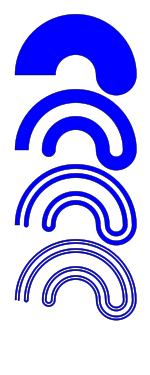Indecomposable continuum

In point-set topology, an indecomposable continuum is a continuum that is not the union of any two of its proper subcontinua. The pseudo-arc is an example of a hereditarily indecomposable continuum. L. E. J. Brouwer (1910) discovered the first indecomposable continuum.[1]
Indecomposable continua have historically appeared as counterexamples to various conjectures, and because of this they are often viewed as pathological objects. However, they can occur in applications, such as attractors in dynamical systems.
Buckethandle
The buckethandle, or B-J-K continuum (for Brouwer, Janiszewski and Knaster) is an indecomposable plane continuum which has a simple construction as the Cantor ternary set C, with semicircles linking its points. We can lay C out along the X-axis of the plane from 0 to 1. If x is in C then so is 1-x, and these points are linked by a semicircle in the positive Y direction. If x is in C, and if it lies between 2/3n and 3/3n (inclusive) for a certain n, then the point (5/3n - x) is also in C and in the same range. These two points are linked by a semicircle in the negative Y direction.
The buckethandle admits no Borel transversal: there is no Borel set containing exactly one point from each composant.
See also
- Indecomposability
- Lakes of Wada, three open subsets of the plane with common boundary an indecomposable continuum.
References
- ↑ Charles E. Aull, Robert Lowen (2001). Handbook of the history of general topology. Springer.
- Brouwer, L. E. J. (1910), "Zur Analysis Situs", Mathematische Annalen, 68 (3): 422–434, doi:10.1007/BF01475781
- Solecki, S. (2002). "Descriptive set theory in topology". In Hušek, M.; van Mill, J. Recent progress in general topology II. Elsevier. pp. 506–508. ISBN 0-444-50980-1.
- Casselman, Bill (2014), "About the cover" (PDF), Notices of the AMS, 61: 610, 676 explains Brouwer's picture of his indeomposable continuum that appears on the front cover of the journal.